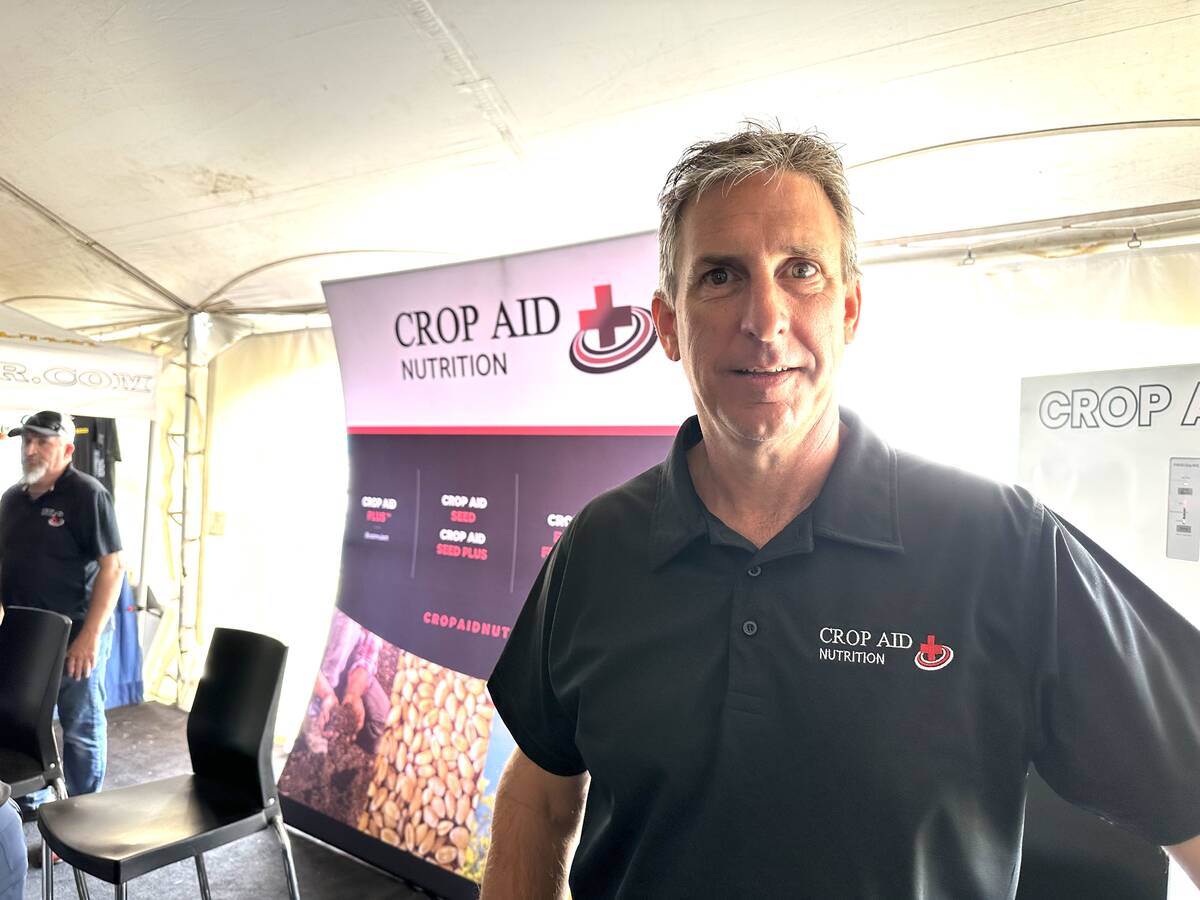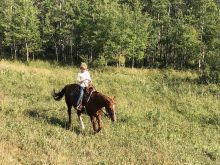“If you take care of the grass, it will take care of you.”
These are the words of wisdom Alberta cattle producer Jerry Baerg received from one of his mentors, and which he has followed as he and his family set about building a sustainable beef operation near Linden in south-central Alberta.
Over the past decade the Baerg family have developed Ribbon Creek Ranch into a sustainable mixed farming operation that includes a commercial cow-calf herd as well as grain and oilseed farming. The enterprise incorporates regenerative practices in its everyday operations.
Read Also

New soil treatment targets saline patches in fields
Crop Aid SS is a Saskatchewan-made spray that’s intended to help farmers manage saline soils by leaching salts away from the root zone.
The Baerg’s efforts in protecting the environment, improving soil health and ensuring animal welfare earned Ribbon Creek Ranch’s recognition in 2022 as winner of the Alberta Beef Producers Environmental Stewardship Award (TESA).
Baerg says he’s amazed and humbled to receive the award, especially since he believes he is only doing what needs to be done to protect the land and make the operation sustainable not only now, but for generations to come.
He says the award is special to his family because it is not about the biggest or best production, but rather environmental stewardship.
Ribbon Creek Ranch
Like the roots of their native grass, the agricultural roots of the Baerg family run deep, extending back to his great-grandfather, who homesteaded in the Linden area in 1901. Jerry’s grandfather farmed in the area his whole life, before the mostly grain farm was passed on to Jerry’s father, Murray. He expanded the operation to include broiler chicken production and a beef backgrounding enterprise.
Jerry and his wife Dawn worked off farm for about five years before returning in 2008. As they got involved, a new vision for the operation started to come into focus about 10 years ago.

“Cows are my passion,” says Baerg. So with that in mind, starting in 2013 it meant the end to raising broilers and moving away from custom-backgrounding cattle to a developing a commercial cow-calf operation. This led to the family buying the property with a lot of native grass east of Linden.
Today, Baerg looks after the beef side of the mixed farm, which includes a 200-head Angus-cross cow-calf herd as well as backgrounding of just their own steers and replacement heifers. He also helps with the no-till annual crop production, with wheat, barley and canola cash crops, as well as oats and peas for livestock feed, all direct seeded. He says it is a priority to apply proper management practices to both annual-crop acres and native grass prairie.
Family affair
The day-to-day operation of Ribbon Creek Ranch is a family affair requiring all hands on deck as much as possible. The Baergs have six children. The two oldest daughters, although no longer living at home, help out when they can, while the four youngest — three sons and daughter ages 6 to 14 — are all still in school, living at home and have taken quite an interest in the operation. They also help with farm chores as much as possible.
“I can be a lot of work, some days are stressful, but we love what we do,” says Baerg.”
On the beef side, two important farm management tools involved construction of proper perimeter- and cross-fencing to accommodate a rotational grazing system, and extending a water system to areas of the pasture to improve livestock distribution.
The fencing system allows them to rotate the cattle through different areas of the pastures in a rest-rotation system. The cattle make a pass through a pasture and are then removed. The rest period allows the grass time to grow back and replenish itself, while the activity of the cattle ensures nutrients are spread throughout the different areas.
While native grass prairie is productive, it is also fragile and needs to be managed properly. Baerg has been building and upgrading fencing on the farm for several years. To help with costs he has accessed the Canadian Agriculture Partnership (CAP) funding program to pay for the supplies. He says electric fencing has been one of the greatest tools in creating a flexible rotational grazing system.
Developing and improving the water system is an important part of pasture management. “Water is a key part of grazing,” says Baerg, noting it can be used to improve livestock distribution. As an example, he took a water trough that was located in a valley that was heavily grazed and moved it to the top of a hill that hadn’t been touched. Moving the trough encouraged cattle to use a different part of the pasture. Baerg has installed 1.5 miles of above-ground pipeline to move well water from the farmyard out to pasture. The water system was installed with the help of funding from the Growing Forward program (now known as CAP) and Kneehill County.
Role for perennial forages
When the grazing land was acquired, Baerg committed to leaving the native grass as is, to be grazed rather than cultivated.
He has stayed true to his commitment, but also started to plant perennial grass into some of the annual cropland, a practice that has turned some heads in an area like Linden where everything is cropland.
Part of the plan is to seed grain crop acres to a blend of perennial forages such as alfalfa, cicer milk vetch, sainfoin and grasses for a few years before returning those acres to annual crops. “It is still a learning curve, but those fields might be in forage crops for seven to eight years before we convert them back to annual crops.”
Baerg is also conducting on-farm trials that involve interseeding clover into some grain fields.
“We did several quarters of barley and before we planted it we broadcast-seeded crimson clover with hopes that the added ground cover would compete with the weeds and the legume would also add nitrogen to the soil.” They planted crimson clover with the barley and some subterranean clover with the wheat.
Baerg says it’s been a learning experience. “We found out later that these clovers are actually a perennial in other parts of the world, but when grown here they act more like an annual. Being perennials, they are slower to establish than we’d hoped — they did not take root and provide the ground cover and weed control like a true annual.
“The subterranean clover did better than the crimson clover because it doesn’t grow as tall. The crimson clover grew to knee height. It wasn’t a bad thing, but I’m not sure I would plant it again. It didn’t cause much problem with harvesting of the barley.”
One benefit was that all the crimson clover was added to crop residue piles, providing a higher-protein winter feed for cows. Along with the feed value, Baerg also liked that clover kept growing after harvest, which benefits the soil. One of the keys of regenerative agriculture is to keep some type of crop green and growing on the land right up until winter freeze-up.
“Having a polyculture or species blend on the land has value in improving soil health, while the legumes will add nitrogen to the soil, as well,” says Baerg. “We also played with another crop combination, planting oats and peas together to generate some supplemental protein for winter. Oats and peas work well because we don’t have to roll the field after seeding.
Growing a cereal and a legume together has several benefits. The oats and peas made a great combination.
“One would shoot up and then the other would shoot up, and they did that all the way until harvest,” says Baerg. “They matured about the same time so we swathed and combined the crop, and they combined well together. The crop residue also made excellent feed for the cattle, and I also have a binful of oats and peas that I’m feeding as a supplement over winter. Straight oats is not a perfect supplement because even though it provides energy, it doesn’t have enough protein, but with peas the protein level is adequate.”
Baerg hopes regenerative agriculture practices will eventually lead to reduced use of crop inputs including fertilizer, insecticides and fungicides. Last year, rather than the conventional seed treatment on the cereal crops, he used a different product which is more of a biological stimulant.
“We liked how that worked, and plan to do it again,” he says. “We don’t want any more pink seed treatment that contains insecticides.” Along with pests, those treatments can also kill beneficial insects, and slow the biology in the soil, which can be even more detrimental.
“We prefer to spray on foliar stimulants later, rather than use a fungicide,” Baerg says. “Last year on some fields we also tried using less nitrogen at time of seeding, and then applied a foliar application of melted urea later.” It takes some experimentation to figure out what works best.
Baerg feels that as soil productivity improves through the use of regenerative agriculture practices, the farm will be able to rely less on traditional production methods that can have harm soil health.
A journey
Baerg says he didn’t have a sustainability plan when he started building his cow herd in 2013. Since then, he has learned a lot about the imortance of protecting grass. He credits mentors and the information he learned through the Foothills Forage and Grazing Association with helping him build up his sustainable practices.
Baerg says his team, which includes his family, veterinarians, nutritionist, and the ranch where he buys his bulls, has allowed Ribbon Creek Ranch to build a successful sustainable plan.
The ranch was nominated for TESA by the Veterinary Agri-Health Services.
Baerg says he wishes more consumers could come out to the farm and see the measures that producers are taking to protect the environment and produce food sustainably.
He says the family cherishes the award because it aligns with their values.
“I’ve been given just a little blip in this history to take care of this land that I have, and I want to hand it along to my children, whoever wants to take it on, better than when I took it.”















